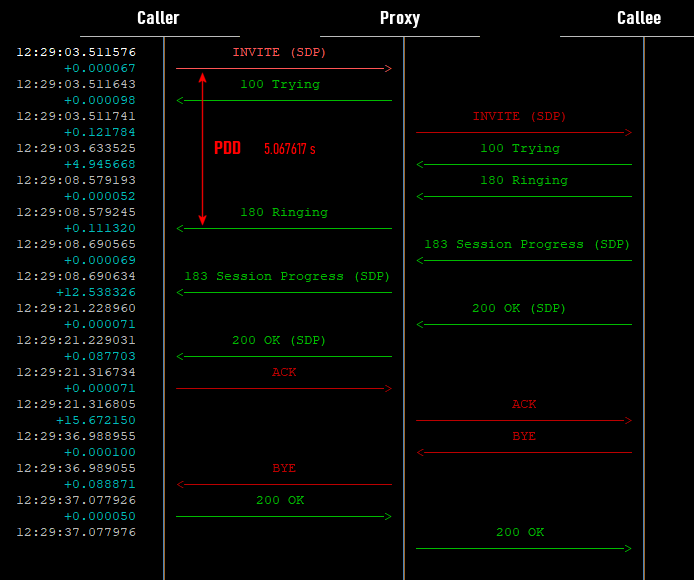This article describes Post Dial Delay (PDD), which in the client’s language is a long delay before a ring tone, a call taking too long to ring, ring delay, and so on.
TL;DR
What is PDD?
PDD is the time that elapses between punching in the last digit of a telephone number and receiving a ring or a busy signal.
Why should I care?
A long PDD impacts ASR and decreases your profit.
What is acceptable?
Anything less than seven seconds is fine.
What causes PDD?
Mainly technical reasons: too many hops, network problems, processing delays, slow DNS.
How can it be fixed?
One quick way is to change your vendor.
The slow way is to analyze PCAP (and then change your vendor).
Definition
Post-dial delay (PDD) is the time taken for a calling party to hear a ringback tone after initiating a call. Technically, it is the time delta between the SIP INVITE and a 180 Ringing or 183 Session Progress response (or a negative response, for example, 480).
It can be represented like this:

For SIP, the PDD would be the time from sending the INVITE to receiving the first ringing response; for example, a SIP/2.0 180 Ringing response. It can also be 183, or negative responses 4xx, 5xx, or 6xx.
Here, PDD is marked in the call flow with the proxy:

PDD is defined in the RFC https://tools.ietf.org/html/rfc6076#section-4.3 as a Session Request Delay (SRD).
What are the consequences of high PDD? Why should I care?
High PDD values are one of the main reasons for a low Average Success Rate, or ASR. People don’t want to wait too long before hearing the ringtone, and they will end the call if it’s not connected in what they consider an acceptable period of time. A low ASR directly reduces your profit, so PDD is one of several important quality metrics of voice traffic. It should be taken seriously.
Acceptable PDD values
Tolerance for PDD varies widely by country. In the USA and Europe, most users will be irritated by a PDD of more than five seconds. But in other locations, such as South America, Africa, and the Middle East, a PDD of 10 seconds or more is common, and even 15 seconds of silence before hearing a ringtone can be tolerated without problems.
On the other side, destinations can have different PDD profiles. For example, PDD could be 8–9 seconds for Syria, but it is around 3–4 seconds for Russia.
In general, a PDD of fewer than three seconds is considered excellent, and more than seven seconds is considered problematic.
Most vendors in the telecommunications industry consider anything under seven seconds to be an acceptable PDD, and most will not troubleshoot a PDD of fewer than seven seconds. The exact value of PDD after which a trouble ticket is accepted from the vendor could be described in the Telecommunication Services Cooperation Agreement.
Reasons for high PDD
The PDD in SIP depends on many factors.
Let’s start with the most obvious: the “between chair and keyboard” problem.
Call Button and Digit Timeout Case
Most desktop phones have a timeout value, after which it is assumed that the user has finished entering the digits, so the phone sends the number to the system and initiates the call. Older people are used to this type of dialing and do not press the Call button (often it’s the # key), but just wait after entering the number they wish to call. There is a delay in most IP phones; they will start dialing after a short period of inactivity by the caller entering a number. That period can be about 3–5 seconds.
This delay when waiting for a timeout (sometimes it’s called the Interdigit Long Timer) is not a PDD but could be mistakenly considered as such. It is important to eliminate this factor before addressing a long PDD.
Too many vendors in the chain
There are big PDD differences between sending traffic directly and sending it through five or six vendors.
A high PDD occurs because each vendor can take a few seconds to acknowledge its ability to complete the call.
Every vendor in the chain adds additional delay and increases the PDD. If possible, use the most direct route, eliminating as many hops as possible.
Improper SIP implementation
Some of the PDD is due to improper SIP signaling responses from destination networks, due to differing interpretations of the SIP RFC. For example, in general, a 180 Ringing response from a destination indicates that the calling party network should play the caller whatever its local ringback tone is, while a 183 Session Progress from a destination includes specific audio in the SDP to be played back to the caller. However, in some cases, a destination may try to provide a specific ringback with a 180 Ringing response, or neglect to provide one with a 183 Session Progress response. Further, in some cases, the ringback provided may be silence. All these issues add up to a longer PDD.
SIP Processing and Connection Delays
This delay depends on a number of factors: processing, message propagation delay on the transport network, packet queueing, and timer usage (SIP timers, TCP timers, etc). The QoS could help here by giving a higher priority to VoIP data.
SIP nodes process the messages on the application layer. This includes, for example, message parsing and header processing. Session handling for authentication and authorization and routing could involve a number of database requests, which could affect PDD. The usual routing delay is 2 ms per node. Together with all the additional tasks, it’s less than 5ms per node.
Geographic distance
PDD can also result from calling destinations geographically remote from the caller.
As signals over the network travel at a finite speed (slightly less than the speed of light), the distance between the caller and callee is directly proportional to PDD. If they are at opposite ends of a continent, the call initiation phase over SIP must traverse the continent several times, for the initial INVITE and the provisional response 180/183, 200 OK, and ACK. Each round trip could be 10–100 ms, and they add up.
Non-geographic destinations such as satellite phones are also prone to greater PDDs.
Network problems
If high PDDs are experienced continually, it could be a case of missed messaging due to one of the hops failing to pass along the correct response messages. A problem in the network layer could be the cause here. Also, a vendor’s server could be overloaded or its system could be broken. That’s hard to identify from your side.
A low signal for wireless devices in the network also causes a high PDD, because the carrier of the number you are dialing has received no indication that the end user’s device is ringing. PDD is widely experienced on wireless devices that have a low signal and are far from their provider’s closest cell tower. So it takes longer for the connection to be established.
Call forwarding
The PDD may also be increased if the destination number you are forwarding to is provided by another call forwarding service, which in turn routes the call onto your actual phone system number. For example, this can happen if you are forwarding calls to a toll-free number vendor, which in turn forwards the call to your local number. Each forwarding takes time.
Delays due to the DNS
SIP servers could use the domain name system to determine the routing of SIP messages. Using the SIP protocol for session initiation on a large scale could place a considerable load on the DNS. If DNS is used, then an additional 20–50 ms of delay may be expected. In extreme cases, it can be up to 2000 ms. If the problem is on your side, you can change the hostname to the direct IP and test it. If the delay disappears, you can be sure the DNS was at fault.
Troubleshooting
The easiest and fastest solution is to change your vendor and compare the PDDs. If the situation improved – you found the solution, if the PDD is the same – the problem is down the line.
If you have to escalate the problem to the vendor, take the PCAP. The example below shows a PDD on the vendor side:

There is nothing better than a PCAP to send to the vendor, in this case with clear evidence that the problem is on their side.
Fake ring
A few words should be said about the fake ring, which is a not-so-nice way to remedy the long PDD problem.
Some NCLI routes can use a low-speed home internet connection, and this will cause high delay times. Providers can use a fake ring to decrease PDD rates. But ASR rates will still be low because people will hear the fake ringtone and still wait too long and think that the person is too busy to answer the phone. Eventually, they will give up. The fake ring is not a solution but a way to mask a problem. Regardless, it is still used by many vendors and it messes up PDD statistics. If you detect it, talk with your vendor. (If they refuse to fix it, change your vendor.)
Conclusion
As you see, a high PDD is one of the most important quality metrics of the traffic route. It affects profits directly. As PDD can be route-specific, it also can be per vendor. There are many reasons for a high PDD, and the quickest way to get rid of it is to change the vendor. If that is not possible, then PCAP is your friend!
Cover from Unsplash.

Thanks a lot for your knowledge sharing.
Appreciate you!